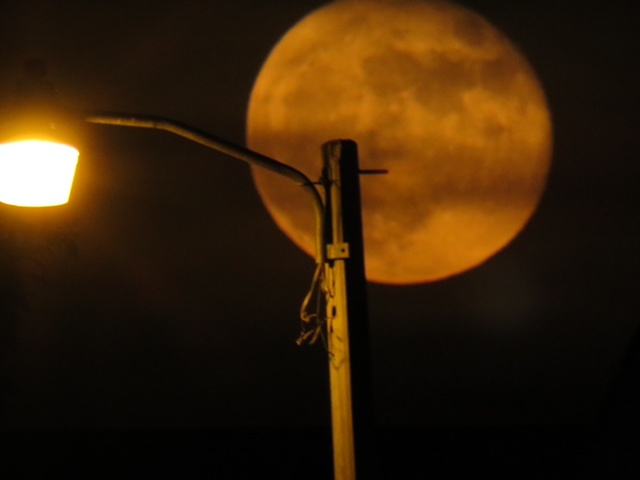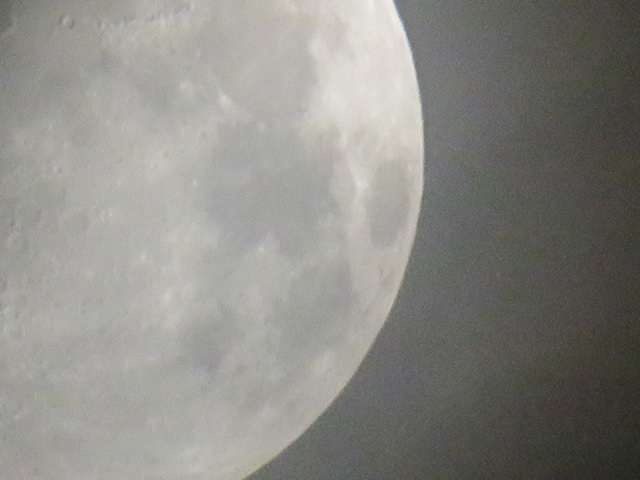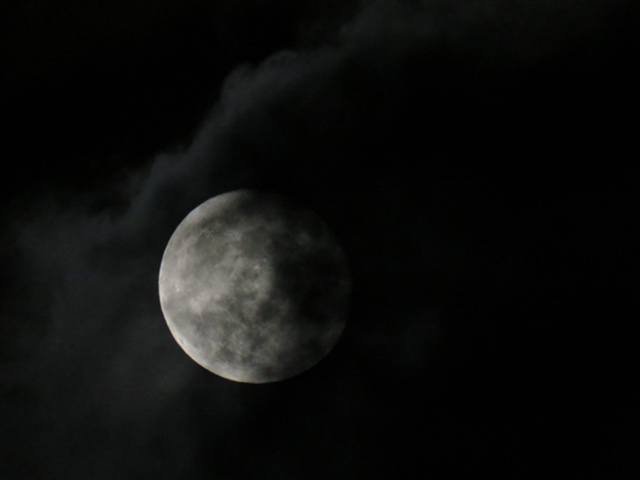It looks like you're using an Ad Blocker.
Please white-list or disable AboveTopSecret.com in your ad-blocking tool.
Thank you.
Some features of ATS will be disabled while you continue to use an ad-blocker.
share:
Apparently NASA are now warning that a 'moon wobble' in the 2030's will start 'a decade of dramatic increases in flood numbers'.
Vid:
Article:
Links:
Wobbling’ moon will cause devastating worldwide flooding in 2030s, Nasa warns
Flooding From Global Warming, Meet Moon ‘Wobble’
Vid:
Article:
NASA: Moon wobble to cause coastal flooding surge by 2030s
WASHINGTON — By the mid-2030s every U.S. coast will experience "rapidly increasing high-tide floods," as a "wobble" in the moon's orbit combines with the effects of climate change, NASA warns in a newly released study.
Members of the NASA Sea Level Change Science Team from the University of Hawaii predict that high tides will top flooding thresholds around the country more often. NASA said the study, published in the journal Nature Climate Change, is the first to take into account all known oceanic and astronomical causes for flooding.
"The combination of the Moon’s gravitational pull, rising sea levels, and climate change will continue to exacerbate coastal flooding on our coastlines and across the world," NASA Administrator Bill Nelson said in a statement. "NASA’s Sea Level Change Team is providing crucial information so that we can plan, protect, and prevent damage to the environment and people’s livelihoods affected by flooding.”
The government agency explained that the moon's "wobble" affects its gravitational pull - which is the main cause of Earth's tides. The wobble, which was first reported in 1782, takes about 18.6 years to complete. During half of which, Earth’s regular daily tides are suppressed. However, for the other half, the tides are "amplified."
The Earth is already dealing with high tide floods due to climate change, so this phenomenon will only make it worse. The National Oceanic and Atmospheric Administration (NOAA) reported a total of more than 600 high tide floods in 2019 in many cities on the U.S. Atlantic and Gulf coasts.
“It’s the accumulated effect over time that will have an impact,” said Phil Thompson, an assistant professor at the University of Hawaii and the lead author of the study. “But if it floods 10 or 15 times a month, a business can’t keep operating with its parking lot under water. People lose their jobs because they can’t get to work.
NASA added that flooding is expected to rise near almost all U.S. mainland coastlines, Hawaii, and Guam. However, northern coastlines like Alaska, might not see any changes for nearly a decade.
link
Links:
Wobbling’ moon will cause devastating worldwide flooding in 2030s, Nasa warns
Flooding From Global Warming, Meet Moon ‘Wobble’
edit on 15-7-2021 by karl 12 because: (no reason given)
Get the Army Corp of Engineers on it. They love pouring cement and diverting waterways, let them handle it.
The problem now is everybody has an agenda especially places like NASA so when stories like this pop, you can have various opinions on them. Being an
ATSer just adds to the potential reasons and potential results.
After all, we got threads that the moon is hollow because of its some monstrous alien satellite or space station. Is this where the long-dormant propulsion systems are firing back up and will eventually zip the moon out of our orbit? or something considerably more benign.
FWIW here's a blurb about moon wobble from 2011 and 2016 about earth wobble
svs.gsfc.nasa.gov...
From Earth we only see one face of the moon. But it's not always the exact same face. The moon rotates once on its own axis during each 27-day journey around the Earth. But as the moon makes its elliptical orbit, its velocity varies and alters that synchronicity, causing our perspective of the "light side" to appear at slightly different angles throughout any given month. In short, the moon wobbles. At least, it does to our eyes. A casual glance skyward won't reveal this, but when a full month of lunar views gets compressed into 12 seconds, as in the visualization below, it's impossible to miss. This rocking like a ship at sea is called libration, from the Latin for balance scale. Instead of just one side, we actually see about 59 percent of the lunar surface over the course of an orbit. The sped up view also reveals how the apparent size of the moon changes in the sky depending on where it is in its elliptical orbit. Its farthest point, the apogee, and nearest point, perigee, differ by more than 10 percent. Watch in the visualization below just how much the moon's face, from a Northern Hemisphere perspective, has wobbled throughout this year.
Earth wobble unsurprisingly is tied to global warming and shifting ice caps and even continental water tables. Not insinuating it is or isn't happening but nowadays you never know. I'm pretty skeptical of the degree of "climate change" humans affect again not saying is doesn't happen.
www.jpl.nasa.gov...
After all, we got threads that the moon is hollow because of its some monstrous alien satellite or space station. Is this where the long-dormant propulsion systems are firing back up and will eventually zip the moon out of our orbit? or something considerably more benign.
FWIW here's a blurb about moon wobble from 2011 and 2016 about earth wobble
svs.gsfc.nasa.gov...
From Earth we only see one face of the moon. But it's not always the exact same face. The moon rotates once on its own axis during each 27-day journey around the Earth. But as the moon makes its elliptical orbit, its velocity varies and alters that synchronicity, causing our perspective of the "light side" to appear at slightly different angles throughout any given month. In short, the moon wobbles. At least, it does to our eyes. A casual glance skyward won't reveal this, but when a full month of lunar views gets compressed into 12 seconds, as in the visualization below, it's impossible to miss. This rocking like a ship at sea is called libration, from the Latin for balance scale. Instead of just one side, we actually see about 59 percent of the lunar surface over the course of an orbit. The sped up view also reveals how the apparent size of the moon changes in the sky depending on where it is in its elliptical orbit. Its farthest point, the apogee, and nearest point, perigee, differ by more than 10 percent. Watch in the visualization below just how much the moon's face, from a Northern Hemisphere perspective, has wobbled throughout this year.
Earth wobble unsurprisingly is tied to global warming and shifting ice caps and even continental water tables. Not insinuating it is or isn't happening but nowadays you never know. I'm pretty skeptical of the degree of "climate change" humans affect again not saying is doesn't happen.
www.jpl.nasa.gov...
edit on 15-7-2021 by putnam6 because: (no reason given)
a reply to: karl 12
Thanks for posting this
Of course I’m seeing this news everywhere now that nasa put it out there. My friend sent me an article yesterday from a news site and then my grandma called telling me she saw a news article bout it.
I’m obsessed with the moon but I didn’t know about this so I tried to do a little bit more digging but then got distracted hah.



The moon is so mysterious .. I love it.
Thanks again, hopefully I can look into this more and not get distracted
Thanks for posting this
Of course I’m seeing this news everywhere now that nasa put it out there. My friend sent me an article yesterday from a news site and then my grandma called telling me she saw a news article bout it.
I’m obsessed with the moon but I didn’t know about this so I tried to do a little bit more digging but then got distracted hah.



The moon is so mysterious .. I love it.
Thanks again, hopefully I can look into this more and not get distracted
edit on 15-7-2021 by CrazyBlueCat because: (no reason given)
a reply to: putnam6
I have been looking into what lies behind the NASA release. It isn't about the wobbles you mention, but a rather different one.
The orbit of the moon is tilted by about 5° from the ecliptic and the orientation of this tilt rotates around the earth.
This rotation takes about 18.5 years.
Adding in the earth tilt of 23° from the ecliptic then the total will vary, with there being something of the order of 10° difference of altitude of the moon depending on the orientation of the moon's orbit tilt.
The articles I've seen suggest that there would be several inches increase in high tides in the 2030s, and that is ignoring global warning melting the ice.
It is not easy to visualize this, and I haven't seen an explanation that is completely clear.
I have been looking into what lies behind the NASA release. It isn't about the wobbles you mention, but a rather different one.
The orbit of the moon is tilted by about 5° from the ecliptic and the orientation of this tilt rotates around the earth.
This rotation takes about 18.5 years.
Adding in the earth tilt of 23° from the ecliptic then the total will vary, with there being something of the order of 10° difference of altitude of the moon depending on the orientation of the moon's orbit tilt.
The articles I've seen suggest that there would be several inches increase in high tides in the 2030s, and that is ignoring global warning melting the ice.
It is not easy to visualize this, and I haven't seen an explanation that is completely clear.
I'm sorry to say it, but this has the immediate look & feel of a misinformation push, giving us some nonsensical, unprecedented bullsh1t to ensure
that in the 2030's, when the elite start openly utilising their weather weaponry against coastal communities all over the world (to spark a
humanitarian refugee crisis on an equally unprecedented scale, probably including a massive depopulation of 'useless' poor people in Southern Asian
coastal communities) - then all the uninformed 'go along to get along' masses in the Western world (otherwise affectionately referred to as 'sheeple')
will stand idly by & whisper "Oh yes, it must be that Moon wobble they talked about when Covid was winding down in 2021").
Because they already practically have all media locked into their narrative control in 2021, by 2030 there will be literally no way to dispute what is pushed over the state-operated airwaves in any meaningful way, the internet will almost certainly have been locked down (..'to control misinformation' is the likely excuse for that particular action).
No matter the clever science which is undoubtedly being wheeled into place to support this ridiculous 'Moon wobble' prediction, I cannot for a moment countenance it as anything but a sort of predictive programming of the masses who are hooked into the social media machine, where this news will probably go viral at some point, if it hasn't already (by design, because they certainly have the ability to influence the trends on social media/ Google, etc).
It is simply a magical explanation which is thoroughly untestable to the billions of humans who will be inundated with coastal flooding when these power-crazed elitists unleash their next generation ionospheric heating mega-machinery to cause the mother of all monsoons, with massive tidal surges, all over the planet (probably actively depopulating the communities of Asia, where these natural events will be amplified to the extreme..)
This will be done as part of a strategy to shoe-horn a global government into power, a true NWO superstate which will be hailed as 'the only solution' to the widespread chaos unleashed by the weather weaponry disguised as a magical & unprecedented 'Moon wobble'. Utter drivel. Problem, reaction, 'solution'.
Because they already practically have all media locked into their narrative control in 2021, by 2030 there will be literally no way to dispute what is pushed over the state-operated airwaves in any meaningful way, the internet will almost certainly have been locked down (..'to control misinformation' is the likely excuse for that particular action).
No matter the clever science which is undoubtedly being wheeled into place to support this ridiculous 'Moon wobble' prediction, I cannot for a moment countenance it as anything but a sort of predictive programming of the masses who are hooked into the social media machine, where this news will probably go viral at some point, if it hasn't already (by design, because they certainly have the ability to influence the trends on social media/ Google, etc).
It is simply a magical explanation which is thoroughly untestable to the billions of humans who will be inundated with coastal flooding when these power-crazed elitists unleash their next generation ionospheric heating mega-machinery to cause the mother of all monsoons, with massive tidal surges, all over the planet (probably actively depopulating the communities of Asia, where these natural events will be amplified to the extreme..)
This will be done as part of a strategy to shoe-horn a global government into power, a true NWO superstate which will be hailed as 'the only solution' to the widespread chaos unleashed by the weather weaponry disguised as a magical & unprecedented 'Moon wobble'. Utter drivel. Problem, reaction, 'solution'.
originally posted by: Darkstar2
a reply to: putnam6
I have been looking into what lies behind the NASA release. It isn't about the wobbles you mention, but a rather different one.
The orbit of the moon is tilted by about 5° from the ecliptic and the orientation of this tilt rotates around the earth.
This rotation takes about 18.5 years.
Adding in the earth tilt of 23° from the ecliptic then the total will vary, with there being something of the order of 10° difference of altitude of the moon depending on the orientation of the moon's orbit tilt.
The articles I've seen suggest that there would be several inches increase in high tides in the 2030s, and that is ignoring global warning melting the ice.
It is not easy to visualize this, and I haven't seen an explanation that is completely clear.
Uh so you agree with the assumption NASA made or disagree and with what evidence of lies? Come on now...
originally posted by: everyone
a reply to: MiaBandetohDoes a Op have to agree or disagree with a topic ?
I wasn't quoting the OP if you read it, but go on...
Hang on…
Doesn’t that coincide perfectly with the Mega Comet or dwarf
Planet entry?
Would a comet or dwaft planet be capable of effecting the moons axis or orbit?
Doesn’t that coincide perfectly with the Mega Comet or dwarf
Planet entry?
It’s thought to be the largest comet yet discovered, possibly as big as a dwarf planet. It’s still far away and hard to see, but the current estimate suggests its nucleus, or core, is between 62 to 230 miles (100 to 370 km) in diameter. Whoa! That’s big for a comet.
The mega comet is not coming very close to us. It’ll make its closest approach in 2031, when it’ll sail just outside of the orbit of our sun’s 6th planet, Saturn. Saturn’s orbit is some nine and a half times farther from the sun than Earth’s orbit. So there’s no danger to us here.
Pedro Bernardinelli announced the discovery on Twitter on June 19, 2021.
Would a comet or dwaft planet be capable of effecting the moons axis or orbit?
edit on 15-7-2021 by TritonTaranis because: (no reason given)
Could someone more knowledgeable than me explain ANY physics that the moon has ANY affect on global warming? And if you can explain the reasoning that
it is the moon then man has minimal impact as the moon is much larger and nothing about it cannot be altered.
a reply to: MiaBandetoh
I agree with NASA - the problem is that they didn't really explain properly the reasons for the release, probably because they didn't believe people would understand the technicalities.
This is something that has irritated me for years - reports don't correctly detail the science, which means I have to chase them down.
I agree with NASA - the problem is that they didn't really explain properly the reasons for the release, probably because they didn't believe people would understand the technicalities.
This is something that has irritated me for years - reports don't correctly detail the science, which means I have to chase them down.
a reply to: TritonTaranis
The 'mega comet' is too far away to have any effect on the inner solar system. Currently it is outside the orbit of Neptune, and will not get any closer than Saturn.
The 'mega comet' is too far away to have any effect on the inner solar system. Currently it is outside the orbit of Neptune, and will not get any closer than Saturn.
originally posted by: Darkstar2
a reply to: TritonTaranis
The 'mega comet' is too far away to have any effect on the inner solar system. Currently it is outside the orbit of Neptune, and will not get any closer than Saturn.
This is ATS
But what if theyre lying
Boom
dum
tshhh
originally posted by: Darkstar2
a reply to: putnam6
I have been looking into what lies behind the NASA release. It isn't about the wobbles you mention, but a rather different one.
The orbit of the moon is tilted by about 5° from the ecliptic and the orientation of this tilt rotates around the earth.
This rotation takes about 18.5 years.
Adding in the earth tilt of 23° from the ecliptic then the total will vary, with there being something of the order of 10° difference of altitude of the moon depending on the orientation of the moon's orbit tilt.
The articles I've seen suggest that there would be several inches increase in high tides in the 2030s, and that is ignoring global warning melting the ice.
It is not easy to visualize this, and I haven't seen an explanation that is completely clear.
Hmmm interesting I'm gonna search for more information on this...
originally posted by: Zanti Misfit
a reply to: karl 12
NASA Control - Mission Accomplished !
That's what I'm thinking too...
As an administrator, it's smart though bang the drum of global warming to congress and get plenty of funding to research this...
new topics
-
January 6th report shows disturbing trend (nobody is shocked)
US Political Madness: 1 hours ago -
Inexplicable military simulation - virtual reality showdown in the night..
The Gray Area: 1 hours ago -
The Truth about Migrant Crime in Britain.
Social Issues and Civil Unrest: 2 hours ago -
Trudeau Resigns! Breaking
Other Current Events: 4 hours ago -
Live updates: Congress meets to certify Trump's presidential election victory
US Political Madness: 5 hours ago -
Gravitic Propulsion--What IF the US and China Really Have it?
General Conspiracies: 5 hours ago -
Greatest thing you ever got, or bought?
General Chit Chat: 6 hours ago
top topics
-
Trudeau Resigns! Breaking
Other Current Events: 4 hours ago, 22 flags -
Live updates: Congress meets to certify Trump's presidential election victory
US Political Madness: 5 hours ago, 12 flags -
OK this is sad but very strange stuff
Paranormal Studies: 17 hours ago, 9 flags -
January 6th report shows disturbing trend (nobody is shocked)
US Political Madness: 1 hours ago, 8 flags -
The Truth about Migrant Crime in Britain.
Social Issues and Civil Unrest: 2 hours ago, 7 flags -
Gravitic Propulsion--What IF the US and China Really Have it?
General Conspiracies: 5 hours ago, 6 flags -
Greatest thing you ever got, or bought?
General Chit Chat: 6 hours ago, 3 flags -
Inexplicable military simulation - virtual reality showdown in the night..
The Gray Area: 1 hours ago, 0 flags
active topics
-
Trudeau Resigns! Breaking
Other Current Events • 52 • : NorthOS -
January 6th report shows disturbing trend (nobody is shocked)
US Political Madness • 4 • : BeyondKnowledge3 -
Sorry to disappoint you but...
US Political Madness • 29 • : Kaiju666 -
The Truth about Migrant Crime in Britain.
Social Issues and Civil Unrest • 11 • : putnam6 -
Greatest thing you ever got, or bought?
General Chit Chat • 20 • : lilzazz -
-@TH3WH17ERABB17- -Q- ---TIME TO SHOW THE WORLD--- -Part- --44--
Dissecting Disinformation • 3952 • : AianawaQ1320 -
Live updates: Congress meets to certify Trump's presidential election victory
US Political Madness • 17 • : Dalamax -
Inexplicable military simulation - virtual reality showdown in the night..
The Gray Area • 1 • : lilzazz -
Gravitic Propulsion--What IF the US and China Really Have it?
General Conspiracies • 7 • : Mantiss2021 -
Musk calls on King Charles III to dissolve Parliament over Oldham sex grooming gangs
Mainstream News • 195 • : Oldcarpy2

